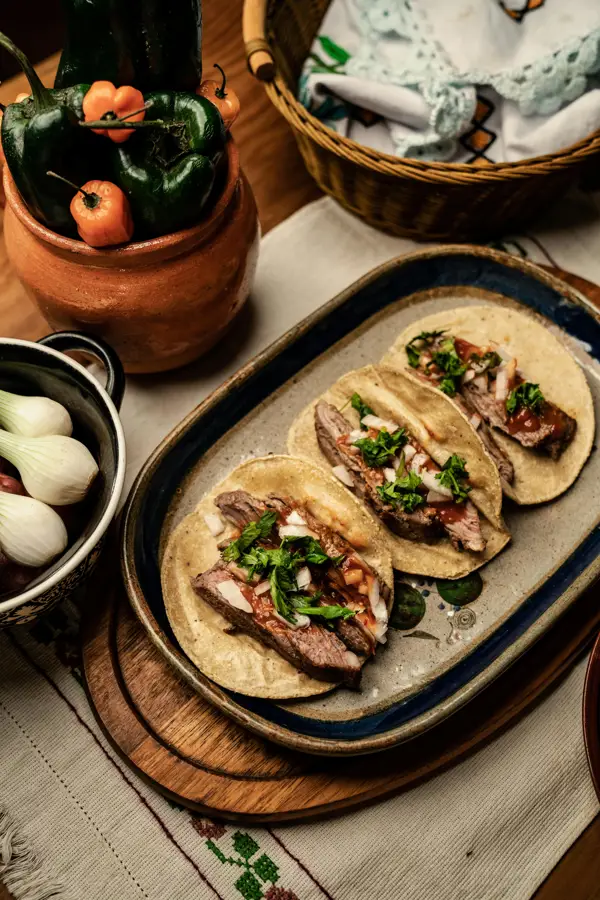Fajitas, a culinary delight that has captivated taste buds worldwide, boast a rich history deeply rooted in Mexican culture. While the exact origins are debated, the most widely accepted narrative points to the Texas-Mexico border region in the mid-20th century. Initially, ranchers and cowboys utilized readily available cuts of beef, specifically skirt steak, grilling them over open fires. This simple yet flavorful method of cooking, born out of necessity and practicality, eventually evolved into the vibrant dish we know and love today. The name fajita itself is believed to be derived from the Spanish word faja, meaning belt or strip, a perfect description of the thinly sliced meat used in the preparation.
The popularity of fajitas exploded in the 1980s, rapidly transitioning from a regional specialty to a national and international phenomenon. This surge in popularity can be attributed to several factors, including the growing accessibility of Mexican cuisine in the United States and the inherent adaptability of the dish. The simple yet customizable nature of fajitas allows for endless variations, catering to diverse palates and preferences. From the type of meat – chicken, beef, shrimp, or even vegetables – to the selection of tortillas and toppings, the possibilities are truly limitless. In fact, the National Restaurant Association reports that Mexican food is consistently among the top three most popular cuisines in the U.S., with fajitas playing a significant role in this success.
Beyond its deliciousness, fajitas hold significant cultural importance. They represent a fusion of culinary traditions, reflecting the vibrant heritage of the borderlands and showcasing the resourcefulness of its people. The communal aspect of sharing fajitas is a key element of their appeal, fostering a sense of togetherness and celebration. The process of assembling your own fajita, selecting your favorite fillings and toppings, adds a personalized touch, transforming a simple meal into a fun and interactive experience. Today, fajitas are a staple at countless restaurants and home kitchens across the globe, a testament to their enduring appeal and lasting cultural impact.
Ingredients and Measurements
This recipe yields approximately 4 servings of delicious grilled chicken fajitas. Accurate measurements are crucial for achieving the perfect balance of flavors. Using a kitchen scale for ingredients like the chicken and peppers will ensure consistency.
Chicken: 1.5 lbs boneless, skinless chicken breasts. Recommendation: Choose chicken breasts that are relatively uniform in size for even cooking. You can use thighs as well, but cooking times may need adjustment. Cut the chicken into 1/4-inch thick strips. This thinner cut ensures quicker grilling and prevents dryness.
Bell Peppers: 2 large bell peppers, assorted colors (e.g., 1 red, 1 green, or your preferred combination). Recommendation: Using a variety of colors not only enhances the visual appeal but also adds subtle differences in flavor. Remove the seeds and membranes before slicing into 1/4-inch thick strips. Aim for consistent sizing to ensure even grilling.
Onion: 1 large white or yellow onion. Recommendation: White onions provide a sharper, more pungent flavor, while yellow onions offer a slightly milder taste. Slice the onion into 1/4-inch thick strips, similar to the peppers. Soaking the sliced onions in cold water for 10-15 minutes before grilling can help reduce their bitterness.
Fajita Seasoning: 2 tablespoons fajita seasoning. Recommendation: You can purchase pre-made fajita seasoning or create your own blend using chili powder, cumin, paprika, garlic powder, onion powder, oregano, and cayenne pepper (for heat). Adjust the amount of seasoning to your preference. Taste before adding to the chicken, and feel free to customize!
Olive Oil: 2 tablespoons extra virgin olive oil. Recommendation: Use a high-quality olive oil for the best flavor. The olive oil helps to tenderize the chicken and adds richness to the overall dish.
Lime Juice: 2 tablespoons fresh lime juice. Recommendation: Freshly squeezed lime juice provides a brighter, more vibrant flavor than bottled juice. This adds acidity to balance the richness of the chicken and peppers
Tortillas: 8-12 small flour or corn tortillas, warmed. Recommendation: Warm the tortillas according to package instructions. This can be done in a dry skillet, microwave, or oven. The warmth makes them more pliable and flavorful.
Salsa: Your favorite store-bought or homemade salsa. Recommendation: Choose a salsa that complements your taste preferences – mild, medium, or hot. Approximately 1-1.5 cups should suffice for four servings.
Optional additions: Consider adding other vegetables such as zucchini or mushrooms. You can also incorporate sour cream, guacamole, shredded cheese, or other toppings to personalize your fajitas.
Equipment and Utensils
To successfully make delicious grilled chicken fajitas with salsa, you’ll need the right tools. Gathering everything beforehand will streamline the cooking process and ensure a smooth experience. Let’s break down the essential equipment and utensils:
For Grilling: You’ll need a grill, of course! This could be a gas grill, charcoal grill, or even a grill pan for indoor cooking. If using a gas grill, ensure it’s clean and preheated to medium-high heat (approximately 375-400°F or 190-200°C). For charcoal grills, aim for a bed of hot coals with a consistent heat zone. Remember to use appropriate safety measures when handling fire and hot surfaces.
For Marinating and Preparing: You’ll need at least two medium-sized bowls: one for marinating the chicken and another for tossing the sliced vegetables. A large, sturdy cutting board is essential for safe and efficient chopping. Invest in a good quality chef’s knife (approximately 8 inches) for slicing the chicken and vegetables. A set of measuring spoons and cups is crucial for accurate ingredient measurements. Using a meat thermometer is highly recommended to ensure the chicken is cooked to a safe internal temperature of 165°F (74°C).
For Serving: You’ll need a serving platter or warm tortillas to keep the fajitas warm and ready to assemble. A set of tongs will be invaluable for flipping the chicken and vegetables on the grill, and also for serving the cooked ingredients. Consider using a small bowl or ramekin for serving the salsa alongside the fajitas.
Optional but Recommended Utensils: While not strictly necessary, a grill brush for cleaning the grill grates before cooking will enhance the overall experience and prevent sticking. A basting brush can be used to apply marinade to the chicken while it grills. Kitchen shears can be helpful for quickly trimming excess fat from the chicken breasts. Paper towels are also useful for patting the chicken dry before marinating.
Specific Measurements: While the exact quantities of ingredients will depend on your recipe, having the right measuring tools ensures consistency and flavour. For example, you’ll need a 1-cup measuring cup for liquids in the marinade and a set of measuring spoons for spices. Accurate measurements are key to achieving the desired taste and texture in your fajitas.
Chicken Preparation (Marination/Seasoning)
The success of your grilled chicken fajitas hinges significantly on the flavor of the chicken. Proper marination and seasoning are key to achieving tender, juicy, and intensely flavorful chicken. This section details how to prepare your chicken for grilling perfection.
Begin with 1.5 lbs of boneless, skinless chicken breasts. Cut the breasts into thin strips, approximately 1/4 inch thick. Consistent thickness ensures even cooking. Using a meat mallet to gently pound the chicken to this thickness will help further speed up the cooking process and create more surface area for flavor absorption.
Now, let’s create the marinade. In a medium-sized bowl, whisk together the following ingredients: 1/4 cup olive oil, 1/4 cup lime juice (freshly squeezed is best!), 2 tablespoons chili powder, 1 tablespoon ground cumin, 1 tablespoon smoked paprika, 1 teaspoon garlic powder, 1 teaspoon onion powder, 1/2 teaspoon oregano, 1/4 teaspoon cayenne pepper (optional, for extra heat), and 1/2 teaspoon salt and 1/4 teaspoon black pepper. Adjust the cayenne pepper to your preferred spice level.
Taste the marinade before adding the chicken. This allows you to adjust the seasoning to your liking. You might want to add more lime juice for acidity, chili powder for heat, or cumin for earthiness. Remember, taste is subjective!
Add the chicken strips to the marinade, ensuring they are fully coated. Use tongs or a spoon to gently toss the chicken, making sure all pieces are evenly saturated with the marinade. Cover the bowl with plastic wrap and refrigerate for at least 30 minutes, or ideally, 2-4 hours. This allows the flavors to penetrate the chicken thoroughly, resulting in a more flavorful and tender final product.
For best results, marinate overnight. The longer the chicken marinates, the more intense the flavor will be. However, 30 minutes is the minimum time required for the marinade to impart some flavor.
Before grilling, remove the chicken from the marinade and let it sit at room temperature for about 15 minutes. This helps it to cook more evenly. Discard any leftover marinade; do not reuse it after it has been in contact with raw chicken.
Important Note: Always ensure your chicken is cooked to a safe internal temperature of 165°F (74°C) before serving. Use a meat thermometer to check the temperature in the thickest part of the chicken.
Vegetable Preparation
The success of your fajitas hinges significantly on perfectly prepared vegetables. We’ll be using bell peppers and onions, a classic combination that delivers both sweetness and bite. For optimal results, aim for vibrant, firm vegetables. Avoid those that are bruised or show signs of wilting.
Begin by washing two large bell peppers (one red, one yellow or orange for color contrast) thoroughly under cold running water. Remove the stems, cores, and any membranes inside. Then, slice each pepper into thin, roughly 1/4-inch wide strips. Consistency in size ensures even cooking. If you prefer a milder flavor, remove the seeds as well, though some people prefer to leave them in for a slightly more intense pepper flavor.
Next, prepare one large white or yellow onion. Peel the onion and cut it in half from top to bottom. Then, slice each half into thin, 1/4-inch wide strips, similar to the peppers. Avoid making the onion slices too thin, as they may burn on the grill. If you are sensitive to onion’s strong aroma, consider briefly rinsing the sliced onion under cold water after slicing to help reduce the pungency.
Once your peppers and onions are sliced, you can choose to toss them with a little oil and seasoning before grilling. This step is optional but highly recommended. In a large bowl, combine the sliced peppers and onions with 2 tablespoons of olive oil, 1 teaspoon of chili powder, 1/2 teaspoon of cumin, 1/4 teaspoon of garlic powder, and salt and pepper to taste. Gently toss until the vegetables are evenly coated. The oil helps to prevent sticking to the grill grates and contributes to a lovely char.
Professional Tip: For even quicker cooking and a more intense flavor, you can marinate the vegetables in the oil and spice mixture for at least 30 minutes before grilling. This allows the flavors to penetrate deeply into the vegetables, enhancing their overall taste.
Important Note: Ensure that your vegetables are completely dry before placing them on the grill. Excess moisture can cause flare-ups and uneven cooking. Pat them gently with paper towels if needed before grilling.
Grilling Techniques (Temperature, Time)
Achieving perfectly grilled chicken for your fajitas hinges on mastering the interplay of temperature and time. Overcooked chicken is dry and tough, while undercooked chicken is unsafe. Therefore, precision is key.
Optimal Grilling Temperature: For chicken breasts, aim for a grill temperature between 350°F and 400°F (175°C and 200°C). This medium-high heat ensures a beautiful sear on the outside while cooking the inside thoroughly. Use a meat thermometer to verify the temperature of your grill; don’t rely solely on visual cues.
Preparing the Chicken: Before grilling, ensure your chicken breasts are uniformly sliced to approximately ½-inch thickness. This consistent thickness promotes even cooking. Marinate the chicken for at least 30 minutes (or up to overnight for maximum flavor) in your favorite fajita marinade. This step adds moisture and tenderizes the meat, resulting in juicier, more flavorful chicken.
Grilling Time: Grilling time depends on the thickness of your chicken and the heat of your grill. For ½-inch thick chicken breasts at 375°F (190°C), expect a grilling time of approximately 6-8 minutes per side. However, the most reliable method is to use a meat thermometer. Insert the thermometer into the thickest part of the chicken; it should register 165°F (74°C) for safe consumption.
Tips for Even Cooking: To prevent flare-ups, trim excess fat from the chicken breasts. Also, avoid overcrowding the grill grates; leave space between the chicken pieces for even heat distribution. If your grill has hot spots, rotate the chicken frequently to ensure even cooking. Don’t press down on the chicken with a spatula while it’s cooking; this will squeeze out the juices and result in dry meat.
Resting the Chicken: Once the chicken reaches the safe internal temperature, remove it from the grill and let it rest for 5-10 minutes before slicing. This allows the juices to redistribute throughout the meat, resulting in a more tender and flavorful final product. Never skip this crucial step!
Monitoring and Adjustments: Keep a close watch on your chicken while it grills. Adjust the grill temperature or move the chicken to a cooler zone if needed to prevent burning. Remember, every grill is different, so you might need to adjust the timing slightly based on your specific equipment and conditions. Always prioritize using a meat thermometer for accurate temperature verification.
Salsa Preparation
Making fresh salsa is a key element to elevating your grilled chicken fajitas. This recipe yields a vibrant, flavorful salsa that perfectly complements the smoky chicken and warm tortillas. We’ll be making a classic pico de gallo, but feel free to adjust the ingredients to your taste preferences.
Ingredients:
- 2 large ripe tomatoes, diced (approximately 2 cups)
- 1/2 medium red onion, finely chopped
- 1 jalapeño pepper, seeded and minced (adjust to your spice preference)
- 1/2 cup chopped fresh cilantro
- 2 tablespoons lime juice (freshly squeezed is best)
- 1 teaspoon ground cumin
- 1/2 teaspoon sea salt
- 1/4 teaspoon black pepper
Instructions:
Begin by preparing your ingredients. Thoroughly wash all your vegetables before chopping. This is crucial for food safety. Dice the tomatoes into roughly 1/2-inch pieces. Avoid over-dicing, as you want to retain some texture in your salsa. Finely chop the red onion; smaller pieces will prevent an overly strong onion flavor. Carefully remove the seeds and membranes from the jalapeño to control the heat level. If you prefer a milder salsa, use less jalapeño or remove more of the seeds. If you’re using a particularly hot jalapeño, wear gloves to avoid skin irritation.
In a medium-sized bowl, gently combine the diced tomatoes, chopped red onion, minced jalapeño, and chopped cilantro. Avoid overmixing, as this can cause the tomatoes to release too much liquid and make your salsa watery. In a small bowl, whisk together the lime juice, cumin, salt, and pepper. Pour this mixture over the tomato mixture and gently toss to combine.
Taste and adjust seasoning as needed. You might want to add more lime juice for extra acidity, or more salt and pepper to balance the flavors. Allow the salsa to sit for at least 15-20 minutes to allow the flavors to meld. This step is crucial for developing the best flavor profile. Refrigerating the salsa for 30 minutes to an hour before serving is also recommended, as this will allow the flavors to deepen and the salsa to chill.
Serve your freshly made salsa alongside your grilled chicken fajitas. Enjoy!
Recommendations
For the most flavorful fajitas, marinate the chicken for at least 30 minutes, or up to overnight in the refrigerator. This allows the chicken to absorb the spices and become incredibly tender. Don’t overcrowd the grill; cook in batches to ensure even browning and cooking through. Using a meat thermometer is highly recommended to ensure the chicken reaches an internal temperature of 165°F (74°C) for food safety.
Once cooked, immediately remove the chicken from the grill and let it rest for about 5-10 minutes before slicing. This allows the juices to redistribute, resulting in more tender and flavorful meat. Slice the chicken against the grain for maximum tenderness. Serve immediately with warm tortillas, your favorite salsa, and all the fixings.
Serving suggestions abound! Consider offering a variety of toppings such as shredded lettuce, diced tomatoes, onions, shredded cheese (cheddar, Monterey Jack, or a Mexican blend), guacamole, sour cream, or pickled jalapeños. For a heartier meal, include some Mexican rice and refried beans as sides. A simple side salad with a lime vinaigrette would also complement the fajitas beautifully.
Storage: Leftover grilled chicken fajitas can be stored in an airtight container in the refrigerator for up to 3 days. Reheat gently in a skillet or microwave until heated through. Do not refreeze previously frozen chicken.
Nutritional Information (per serving, approximate, varies based on ingredients and portion size): Calories: 350-450; Protein: 30-40g; Fat: 15-25g; Carbohydrates: 20-30g. This information is an estimate and may vary depending on the specific ingredients used and portion sizes. For a more precise nutritional breakdown, use a nutrition calculator and input your specific recipe details.
Important Note: Always ensure your chicken is cooked to a safe internal temperature to prevent foodborne illness. Adjust seasoning and ingredients according to your preferences. Enjoy your delicious and healthy grilled chicken fajitas!





